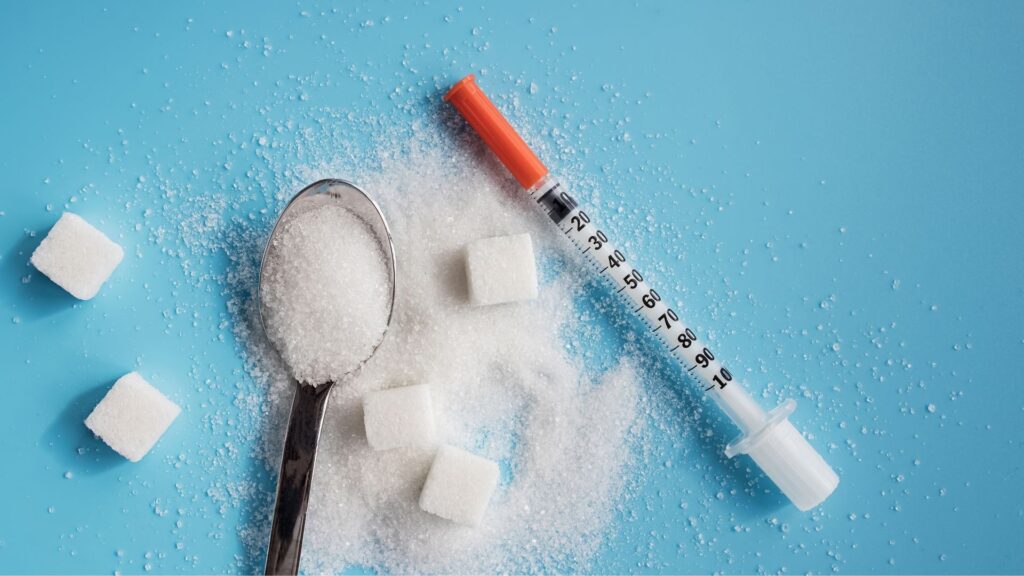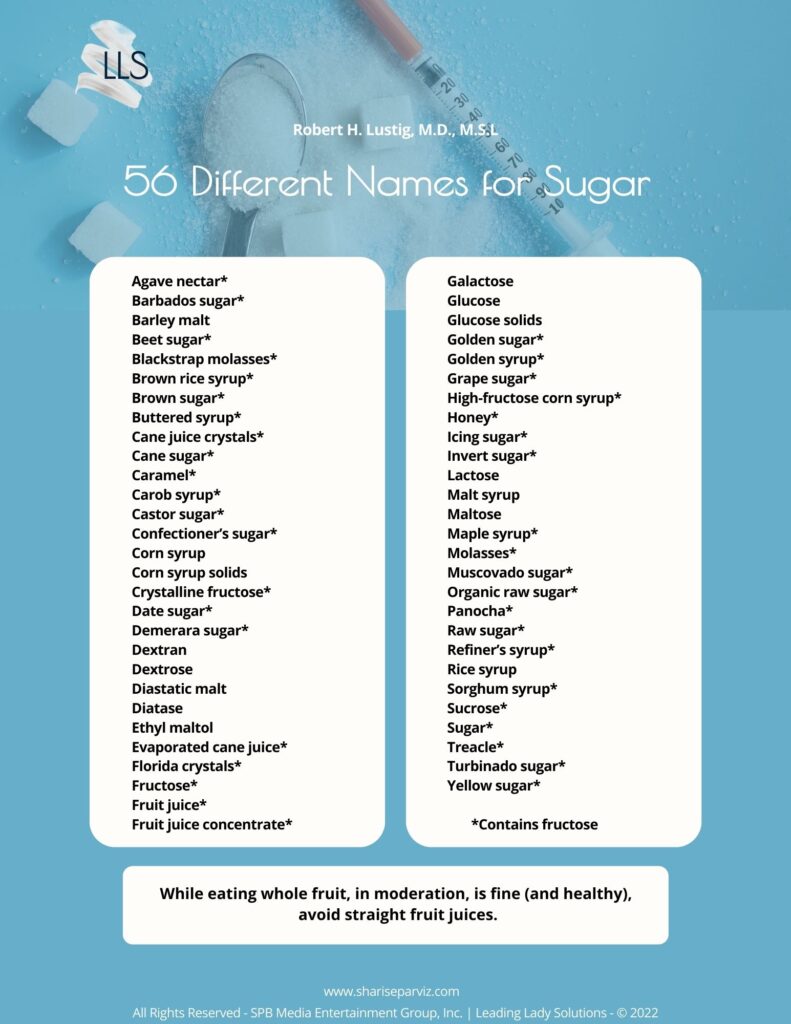
56 Different Names for Sugar
You’re doing all you can to live a healthy life, but the food industry is working against you. It has been shown that food manufacturers literally do research on how to make you more addicted to their foods. The more you eat, the more money they make. Cha-ching.
And while we may try to avoid the top sources of sugar such as soft drinks, fruit drinks, flavored yogurts, cereals, cookies, cakes, candy, and most processed foods, added sugar is also present in items that you may not think of as sweetened, like soups, bread, cured meats, and ketchup.
Dangerous Numbers
According to the American Heart Association, American adults consume an average of 77 grams of sugar per day, more than 3 times the recommended amount for women. This adds up to around 60 pounds of added sugar annually – that’s six, 10-pound bowling balls, folks!
The numbers are even worse for children.
American kids consume 81 grams per day, equaling over 65 pounds of added sugar per year. Think of it this way – children are ingesting over 30 gallons of added sugars from beverages alone.
A Link to Excess Sugar Consumption and Fatty Liver Disease
Studies are showing that over-consumption of sugar is a leading cause in Nonalcoholic Fatty Liver Disease (NAFLD) and parallels the rise of obesity and diabetes. And NAFLD is on the rise in both adults AND children.
Just let that sink in. What are we doing to ourselves and our children?
Sugar is Addictive
At the same time sugar activates opiate and dopamine receptors in the brain. Ironically, these are the same “happy” chemicals that cause us to feel good when hanging out with loved ones and good friends, and the same chemical that releases in the body during illicit drug use.
Studies suggest that every time we eat sweets, we are reinforcing the neural pathways associated with addiction, causing the brain to become increasingly hardwired to crave more sugar.
The US is one of the Top Sugar Producers
Currently, the global production of sugar exceeds 180 million metric tons annually. The United States was ranked among the top producers, generating just under 8.4 million metric tons in 2021/22.
With that kind of demand, it’s no wonder that we’re sick
Other Dangers of Excess Sugar Consumption
- Lowers Immune system
- Obesity
- Heart disease
- Hypertension
- Type 2 diabetes
- Epithelial cell cancers
- Inflammatory diseases (including autoimmune diseases, bowel disorders, osteoporosis, infertility, and more)
- Accelerated aging
- Tooth decay
But it doesn’t have to be this way. We can kick sugar to the curb.
I use to be a sugar addict and today I don’t crave it or rarely even have a taste for it. Learning to nourish my body with what it truly craved, is when sugar no longer had a hold on me. We don’t have to be a slave to sugar or the food industry.
The Hidden Ingredient
Many of us have made the switch to eating real, organic, whole foods, but the food industry just keeps getting sneakier. Hiding sugar under unrecognizable names on food labels. I wanted to share the 56 Different Names for Sugar by Dr. Robert H. Lustig and what he’s doing to combat this important health issue. Please visit the links below for more insight.
By Dr. Robert H. Lustig, M.D., M.S.L.
Dr. Lustig has fostered a global discussion of metabolic health and nutrition, exposing some of the leading myths that underlie the current pandemic of diet-related disease. He believes the food business, by pushing processed food loaded with sugar, has hacked our bodies and minds to pursue pleasure instead of happiness; fostering today’s epidemics of addiction and depression. Yet by focusing on real food, we can beat the odds against sugar, processed food, obesity, and disease.
Unfortunately, sugar is not always conveniently labeled as “sugar” in the ingredients list. The food industry has discovered new ways to hide the amount of added sugar in their products by disguising them as different names that don’t seem so bad. Brown rice is healthy so that means brown rice syrup is too, right?
Dr. Lustig’s book Sugar Has 56 Names: A Shopper’s Guide is enlightening for those who may not realize the extent that sugar is added to our food products.
“Sugar has 56 Names” only scratched the surface of all the other names which have been reported to me. By now I am aware of over 300 names. Please help me and an innovative start up called “perfact” collect basic data on added sugars so we can publish an updated “sugar matrix” in a collaborative open-knowledge format. If your contribution is helpful, you will be listed as a contributor.
Get involved with the Sugar Matrix Project (click here) – Dr. Robert H. Lustig, M.D., M.S.L.
Robert H. Lustig, M.D., M.S.L.
is Professor emeritus of Pediatrics, Division of Endocrinology at the University of California, San Francisco (UCSF). He specializes in the field of neuroendocrinology, with an emphasis on the regulation of energy balance by the central nervous system. His research and clinical practice has focused on childhood obesity and diabetes. Dr. Lustig holds a Bachelor’s in Science from MIT, a Doctorate in Medicine from Cornell University. Medical College, and a Master’s of Studies in Law from U.C. Hastings College of the Law.
While I am providing Dr. Lustig’s list, I strongly recommend reading “Sugar Has 56 Names: A Shopper’s Guide for greater depth of detail and insight.

Here are a few ways to become more aware:
Remember, the commercial food industry researches ways to make us addicted to their foods. Additives, flavorings, and hidden sugars are added to make us eat and eat and eat and eat. The more we eat, the more money they make.
So,
- Read your labels.
- Look for hidden sugars under disguised names.
- Beware of low-fat/nonfat foods (sugar is usually added to make these foods palatable).
- Beware of anything “diet” – the synthetic sweeteners can kick off a sugar craving (and they’re utterly unhealthy for you).
- Opt for healthier substitutes. While they are on the list, I do use molasses, honey, and maple syrup. Studies have shown they do not create that “dopamine hit” (and they have some health benefits), so they may be used in moderation. Stevia is also a great alternative (and one of my favorites).
- While eating whole fruit is fine (and healthy), in moderation, avoid straight fruit juices.
- Finally learn to listen to your body and feed it what it’s truly hungry for.
For my FREEBIE printable list of the 56 names to take on your next shopping trip, click here
And visit Dr. Lustig’s website, here
Other books I recommend by Dr. Lustig are:

